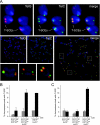Functional dissection of human and mouse POT1 proteins
- PMID: 18955498
- PMCID: PMC2612509
- DOI: 10.1128/MCB.01352-08
Functional dissection of human and mouse POT1 proteins
Abstract
The single-stranded telomeric DNA binding protein POT1 protects mammalian chromosome ends from the ATR-dependent DNA damage response, regulates telomerase-mediated telomere extension, and limits 5'-end resection at telomere termini. Whereas most mammals have a single POT1 gene, mice have two POT1 proteins that are functionally distinct. POT1a represses the DNA damage response, and POT1b controls 5'-end resection. In contrast, as we report here, POT1a and POT1b do not differ in their ability to repress telomere recombination. By swapping domains, we show that the DNA binding domain of POT1a specifies its ability to repress the DNA damage response. However, no differences were detected in the in vitro DNA binding features of POT1a and POT1b. In contrast to the repression of ATR signaling by POT1a, the ability of POT1b to control 5'-end resection was found to require two regions in the C terminus, one corresponding to the TPP1 binding domain and a second representing a new domain located between amino acids (aa) 300 and 350. Interestingly, the DNA binding domain of human POT1 can replace that of POT1a to repress ATR signaling, and the POT1b region from aa 300 to 350 required for the regulation of the telomere terminus is functionally conserved in human POT1. Thus, human POT1 combines the features of POT1a and POT1b.
Figures








Similar articles
-
Telomere protection by TPP1 is mediated by POT1a and POT1b.Mol Cell Biol. 2010 Feb;30(4):1059-66. doi: 10.1128/MCB.01498-09. Epub 2009 Dec 7. Mol Cell Biol. 2010. PMID: 19995905 Free PMC article.
-
Protection of telomeres 1 proteins POT1a and POT1b can repress ATR signaling by RPA exclusion, but binding to CST limits ATR repression by POT1b.J Biol Chem. 2018 Sep 14;293(37):14384-14392. doi: 10.1074/jbc.RA118.004598. Epub 2018 Aug 6. J Biol Chem. 2018. PMID: 30082315 Free PMC article.
-
Distinct functions of POT1 proteins contribute to the regulation of telomerase recruitment to telomeres.Nat Commun. 2021 Sep 17;12(1):5514. doi: 10.1038/s41467-021-25799-7. Nat Commun. 2021. PMID: 34535663 Free PMC article.
-
Shelterin: the protein complex that shapes and safeguards human telomeres.Genes Dev. 2005 Sep 15;19(18):2100-10. doi: 10.1101/gad.1346005. Genes Dev. 2005. PMID: 16166375 Review.
-
POT1-TPP1 telomere length regulation and disease.Comput Struct Biotechnol J. 2020 Jul 3;18:1939-1946. doi: 10.1016/j.csbj.2020.06.040. eCollection 2020. Comput Struct Biotechnol J. 2020. PMID: 32774788 Free PMC article. Review.
Cited by
-
RPA and POT1: friends or foes at telomeres?Cell Cycle. 2012 Feb 15;11(4):652-7. doi: 10.4161/cc.11.4.19061. Cell Cycle. 2012. PMID: 22373525 Free PMC article.
-
Telomeres-structure, function, and regulation.Exp Cell Res. 2013 Jan 15;319(2):133-41. doi: 10.1016/j.yexcr.2012.09.005. Epub 2012 Sep 21. Exp Cell Res. 2013. PMID: 23006819 Free PMC article. Review.
-
Similarities and differences between "uncapped" telomeres and DNA double-strand breaks.Chromosoma. 2012 Apr;121(2):117-30. doi: 10.1007/s00412-011-0357-2. Epub 2011 Dec 28. Chromosoma. 2012. PMID: 22203190 Review.
-
p16(INK4a) protects against dysfunctional telomere-induced ATR-dependent DNA damage responses.J Clin Invest. 2013 Oct;123(10):4489-501. doi: 10.1172/JCI69574. Epub 2013 Sep 16. J Clin Invest. 2013. PMID: 24091330 Free PMC article.
-
Expression of Shelterin component POT1 is associated with decreased telomere length and immunity condition in humans with severe aplastic anemia.J Immunol Res. 2014;2014:439530. doi: 10.1155/2014/439530. Epub 2014 May 6. J Immunol Res. 2014. PMID: 24892036 Free PMC article.
References
-
- Baumann, P., and T. R. Cech. 2001. Pot1, the putative telomere end-binding protein in fission yeast and humans. Science 2921171-1175. - PubMed
-
- Celli, G., and T. de Lange. 2005. DNA processing not required for ATM-mediated telomere damage response after TRF2 deletion. Nat. Cell Biol. 7712-718. - PubMed
-
- Celli, G. B., E. Lazzerini Denchi, and T. de Lange. 2006. Ku70 stimulates fusion of dysfunctional telomeres yet protects chromosome ends from homologous recombination. Nat. Cell Biol. 8885-890. - PubMed
-
- de Lange, T. 2005. Shelterin: the protein complex that shapes and safeguards human telomeres. Genes Dev. 192100-2110. - PubMed
Publication types
MeSH terms
Substances
Grants and funding
LinkOut - more resources
Full Text Sources
Molecular Biology Databases
Research Materials
Miscellaneous
